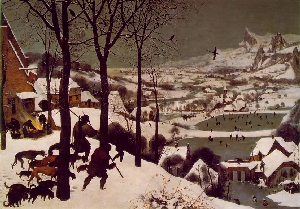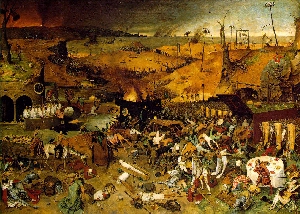|
Peasant
wedding |
One of the most perfect of Bruegel's human comedies is his famous picture of a country wedding. Like most pictures, it loses a great deal in reproduction: all details become much smaller, and we must therefore look at it with double care. The feast takes place in a barn, with straw stacked up high in the background. The bride sits in front of a piece of blue cloth, with a kind of crown suspended over her head. She sits quietly, with folded hands and a grin of utter contentment on her stupid face. The old man in the chair and the woman beside her are probably her parents, while the man farther back, who is so busy gobbling his food with his spoon, may be the bridegroom. Most of the people at the table concentrate on eating and drinking, and we notice this is only the beginning. In the left-hand corner a man pours out beer - a good number of empty jugs are still in the basket - while two men with white aprons are carrying ten more platefuls of pie or porridge on an Improvised tray.One of the guests passes the plates to the table. But much more is going on. There is the crowd in the background trying to get in; there are the musicians, one of them with a pathetic, forlorn and hungry look in his eyes, as he watches the food being carried past; there are the two outsiders at the corner of the table, the friar |


